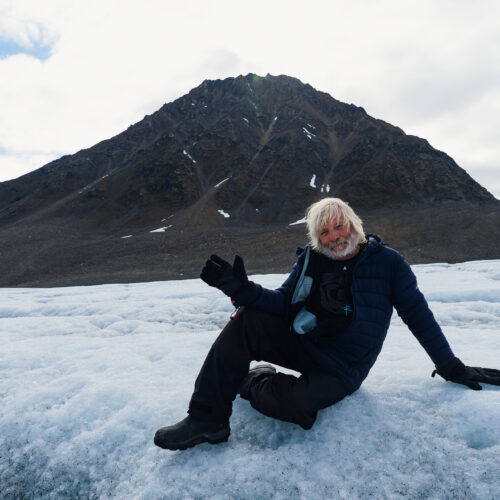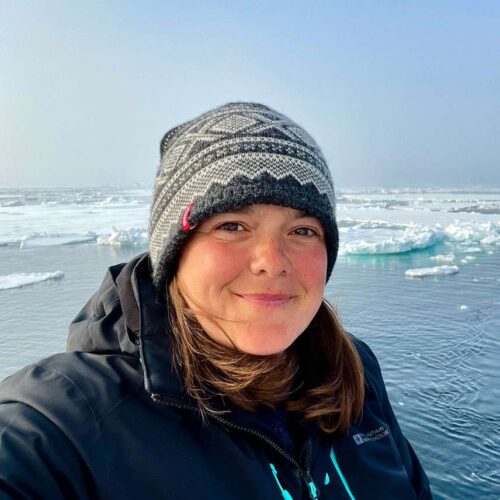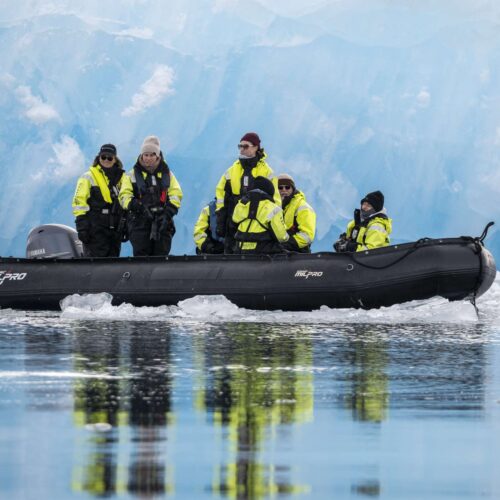Animals of Antarctica – The Ultimate Guide to Antarctica’s Wildlife
Welcome to our Antarctica wildlife guide.
Antarctica – The land of ice and snow. The white continent is one of the most extreme habitats. It is colder and windier than in any other place on Earth. And yet it is home to an abundance of wildlife – from emperor penguins and orcas to leopard seals and albatrosses. But that’s just the tip of the iceberg when it comes to the vast array of animals that call this unique continent home.
Antarctica is a barren desert and these are all wild animals which are, and should be, wary of humans so we cannot guarantee sightings, but you’re in with a good chance on an expedition micro cruise, which is much less intrusive than larger vessels and can get closer to the action.
Here is a list of animals you may see during your Antarctica Cruise.
Join Our newsletter
Join our mailing list and get a free copy of our Explorers Club Magazine delivered to your inbox.
Penguins
Chinstrap Penguin
The Chinstrap Penguin is the most abundant penguin species of all, with an estimated population of 7.5 million breeding pairs. They inhabit the northern part of the Antarctic Peninsula, as well as the sub-Antarctic islands and islands surrounding the continent. The largest colonies are found on the South Sandwich Islands. A distinctive black line that looks like a chinstrap gives them their name. Chinstrap are very social and are therefore often seen with other penguin species, such as Adélie penguins. The biggest threat to Chinstrap penguins in the water, as to all penguins, are leopard seals and killer whales. Rising temperatures, linked to climate change, are causing krill populations to fall and rise. This has an effect on penguin populations, which count krill as a large part of their diet. On land, they have to watch out for skuas, which like to feast on their eggs and chicks.

Adélie Penguin
Adélie penguins are found in coastal areas and on small islands around the continent. During the warm months, from October to February, Adelie penguins are mainly on land to breed and raise their chicks. Less is known about their behavior in winter because they spend it out at sea in the pack ice. They are excellent swimmers and can dive as deep as 175 m to catch fish, krill and amphipods. Scientists also believe that they can move more than 1200 km from the breeding ground during the winter months.

Emperor Penguin
With an average size of 120cm, emperor penguins are the largest penguin species in the world. There are an estimated 50 colonies living on the Antarctic coastline. (Check out a map of its range.) Each colony can be made up of around 5000 penguins. In fact, they are so large that they can be seen on satellite images. Unlike many other penguin species, they are perfectly adapted to ice and snow. Therefore, they inhabit the whole Antarctic coastline and you can see them often gathering on icebergs. They are not only the largest penguins, but also the world’s deepest diving birds. They can dive up to 550 meters deep and stay underwater for over 20 minutes. Emperor penguins are highly threatened by the effects of climate change. Unlike other species, they are very dependent on the ice because it is where they raise their young. They also feed primarily on krill, which is disappearing due to rising ocean temperatures.

Gentoo Penguin
Gentoo penguins are relatively rare to see and less curious than other species. Nevertheless, there are chances to meet them on an expedition, because there are some places where the colonies stay firmly. Like most penguin species, they inhabit the shorelines of the Antarctic Peninsula and many sub-Antarctic islands, such as the Falkland Islands. Only about 13% of Gentoo penguins live south of the Antarctic pack ice. Gentoo penguins raise 2 chicks per year and not one like other penguins. Every year they mate with the same partner and they usually remain loyal for life. Kind of cute, isn’t it?

Macaroni Penguin
The Macaroni Penguin is closely related to the Royal Penguin. With their crest of yellow-orange feathers on their head, they are probably one of the most fashionable penguin species. Macaroni Penguins are found on many subantarctic islands and on the Antarctic Peninsula and on some islands off the coast of Argentina and Chile. During the breeding season, the Macaroni Penguin feeds almost exclusively on krill and it is said that they eat several million krill per year. In fact, they eat more than any other seabird.

King Penguin
King Penguins are easily confused with emperor penguins. In fact, the name comes from the original belief that king penguins are the largest species of penguin. Its size, the long and stout bill and orange-yellow feathers on its upper chest and head distinguish the king penguin from its relatives in Antarctica. King penguins are known to live in vast colonies.They prefer to stay on sub-Antarctic islands rather than in Antarctica itself and inhabit shores and valleys without snow and ice. Fish makes up the largest part of a penguin’s diet. They catch up to 2000 fish a day and dive up to 350 meters deep to do so. King penguins are provided with very good night vision. Like emperor penguins, king penguins do not breed in nests, but keep their eggs warm beneath their brood pouch.

Whales
Orca
Orcas are one of the most feared predators of the marine ecosystem. However, contrary to their name, they are completely harmless to humans. Worldwide, there is not a single known case of a human being being attacked by an orca in the wild. The dolphin-related whales can be found almost everywhere in the world’s oceans. It’s hard to keep track of how many there are because they are so widespread. But there is a consensus that there are at least 50,000 individuals worldwide. Most Orcas prefer to stay in Antarctic waters. Orcas are among the most intelligent animals in the world with complex social structures and hunting behavior. They hunt mainly in groups, using a very special technique called wave hunting. Together, they create a large wave that floods ice floes, washing resting seals or penguins off the floe. Watch their remarkable hunting techniques here:

Blue Whale
Blue whales are the largest existing creatures on earth, reaching a length of 30 meters and weighing up to 200 tons. Female blue whales are usually larger than males and the largest individuals live in the southern oceans. In winter, most blue whales migrate to the equator to breed. After 12 months of gestation, the calves are born. They are already 8 meters big at birth. In the first half of the 20th century, the blue whale was almost exterminated by commercialized whaling. Since the 1960s, the blue whale has been protected. But populations seem to be recovering only slowly and the blue whales remain on the endangered species list.

Humpback Whale
Humpback whales are the most common whale species in Antarctica. Chances are high that you see them on one of our Antarctic expeditions. Like penguins, seals and other whales, they mainly feed on Antarctic krill and small fish using various hunting techniques. One well-known method is bubble netting. This technique involves several humpback whales swimming under a group of fish and circling it. Then the whales start blowing bubbles to further enclose the circle of fish. Once they have herded the fish together, they can swim through it with their mouths open and filter out the krill.

Minke Whale
Minke whales belong to the smaller whale species. There are two types of minke whales, the common minke whale and the Antarctic minke whale. Antarctic minke whales live exclusively in the southern oceans. Some of them migrate a little north in the winter to warmer waters, while others stay off the coasts of Antarctica all year round. Fun Fact, they are also called “Stinky Minkes” because of their smelly spouts. We recommend keeping a safe distance. 😉

Sperm Whale
Sperm whales are probably one of the most unique creatures on earth. They spend a large part of their lives in the depths of the seas. In fact, only male sperm whales are found in Antarctic waters. Male individuals are usually one and a half times larger than females. The main part of their diet is Giant Squid, for which they dive up to 3000 meters. Sperm whales are very sociable and live in groups of up to 50 members. The bond among them is so strong that it usually lasts a lifetime.

Seals
Leopard Seal
The Leopard seal is one of the top predators of the Antarctic. Penguins, other seals and seabirds are constantly threatened by the large seals. But are they really as evil and bad as some documentaries portray them? The answer is no. Leopard Seals keep the numbers in check. Many other populations would grow too large without them, such as penguin and fur seal populations.

Ross Seal
The name of this seal goes back to the Ross Sea. The Ross Sea is a marginal sea in the southern Ocean off the Antarctic coast. However, their habitat is not limited to the Ross Sea and they live all around the continent. Ross seals have a very atypical appearance and are much smaller than other Antarctic seals. As they don´t leave Antarctic waters, little is known about the Ross Seal. Recent estimates suggest that the population may be approximately 200,000.
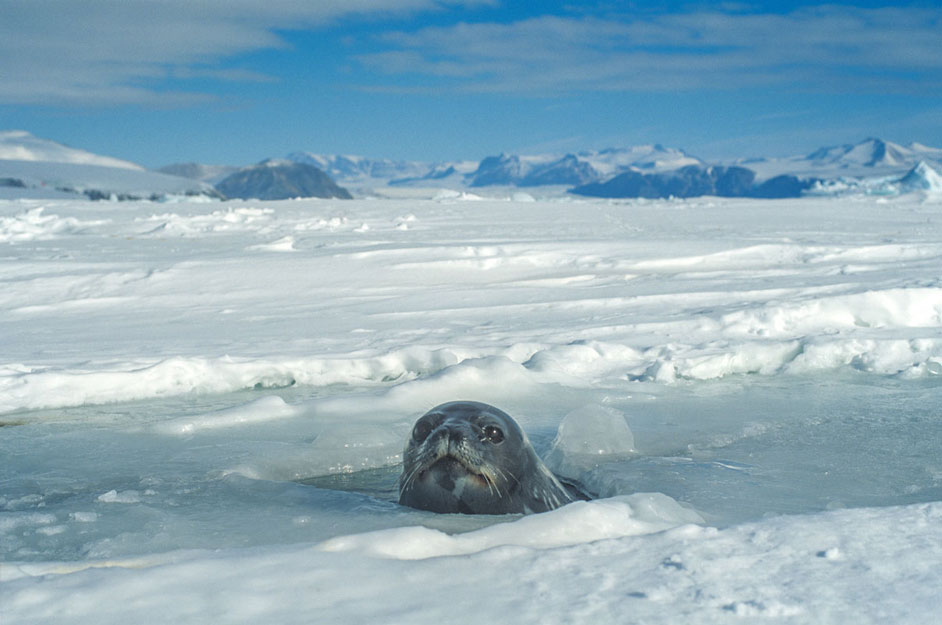
Weddell Seal
The Weddell seal is the most common seal in Antarctica. They live around the continent, on the edge of the pack ice. In the Antarctic winter, Weddell seals do not migrate north, but stay in the ice and keep an ice hole open. They are perfectly adapted to life in the ice. In fact, there are no other seals that live further south. Weddell seals can grow up to 3.5 meters tall and weigh up to 600 kg. Since they have a lot of red blood cells, they are also excellent divers. They can stay underwater for up to 80 minutes. The main part of their diet is squid, fish and krill.

Crabeater Seal
The crabeater seal is named after its diet. It is the only seal species that feeds mainly on krill. In fact, Antarctic krill makes up more than 90% of its diet. They have a special tooth structure to filter the krill, which works much like the beard of whales. More krill becomes available to the seals as whale populations are declining. Estimates suggest that there are 30 million individuals worldwide today.

Antarctic Fur Seal
The habitat of the Antarctic fur seal covers the islands around Antarctica, rather than the continent itself. The largest colonies are found in South Georgia Island. Towards the end of the 19th century, the fur seal was almost extinct because of its fur. By 1930, there was a remaining population of about 100 individuals. It is a miracle that the species was able to recover and breed in large numbers again. Fur seals are easily confused with sea lions because of their appearance. They have a more pointed nose and a longer neck than other seals. There is also a blonde variant of the seal species. 1 in 1000 baby seals are born with a lighter color. Their main threats are leopard seals and declining krill stocks.
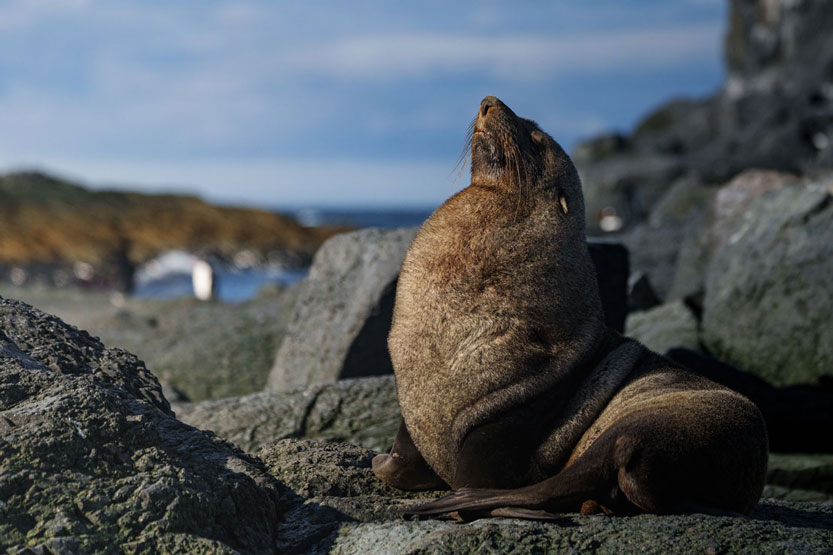
Sea Elephant Seal
Sea elephants are the largest seals in the world. The enlarged nose of male individuals resembles an elephant’s trunk. That is where its name comes from. A bull can grow to six and a half meters, while a female is only three and a half meters. Elephant seals are solitary animals, but at mating time they gather together in large colonies. Fighting and vocalizations are used by male elephant seals to determine the dominant males.The bulls can be a great danger for the calves, and it is not uncommon for some of them to die of their reckless behavior.
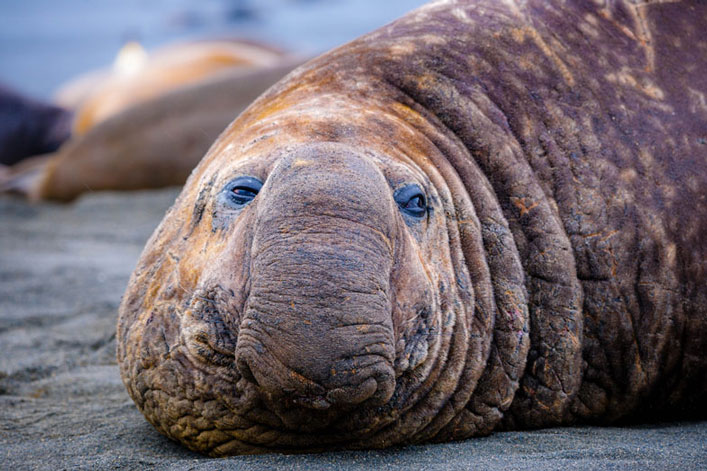
Birdlife
Albatross
Different species of the Albatross family inhabit the southern part of the globe, and – even though they might look similar on the first view – display a diverse set of different characteristics. The Wandering Albatross for example – which got its scientific name from the Greek mythological hero Diomedes – gets whiter as it gets older. On the other hand, the Grey-headed Albatross’ dominating color is grey. In comparison to the other species of this fascinating bird family the Grey-headed Albatross is the one that breeds the furthest south. Opposite to most other Albatrosses, the Black-browed Albatross is not a solitary bird on sea, and even follows shipping boats and other birds to get easy access to food. Last but not least, Light-mantled Albatross has overall a light brown appearance and interestingly likes to follow whales and dolphins in order to save energy from hunting.
All in all, Albatrosses are incredibly fascinating – they are uniquely huge birds, and some species can even reach up to 70 years of age. Nevertheless, they are also increasingly endangered, foremost because of climate change, and protecting them and their habitat should be a number one priority for everyone.
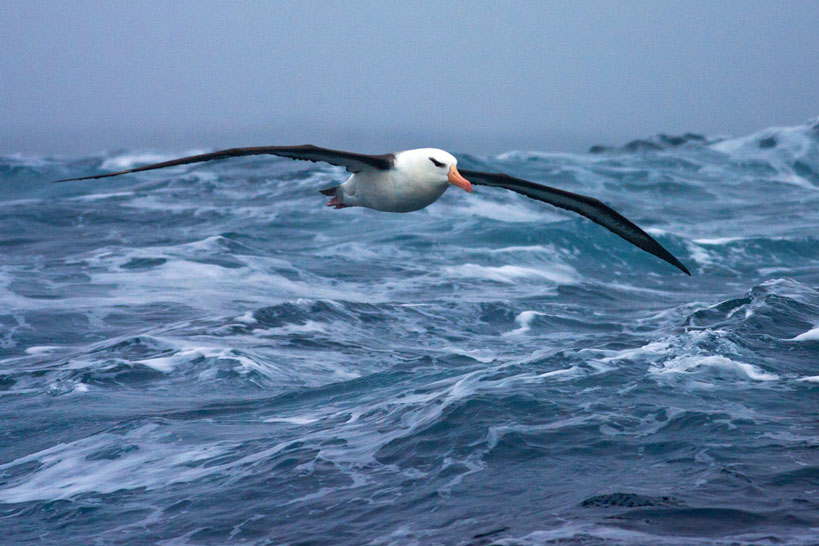
South Polar Skua, Brown Skua
Skuas are a family of huge seabirds that breed in both the Northern and the Southern part of the globe and are infamous for attacking other animals such as gulls or terns in order to force them to surrender their prey. The South Polar Skua is rather infamous for hunting penguin eggs and chicks, and breeds in (almost) all of Antarctica and migrates North in the winter. Quite similarly, the Brown Skua is also colored unremarkably grey-brown and lives in roughly the same region. It is the largest of all Skuas, and is – like all other species in this family – quite aggressive, in some rare cases even towards humans.

Sheathbill
There are two different kinds of sheathbills in the Antarctic region: The Snowy Sheathbill and the Black-faced Sheathbill. The Snowy Sheathbill is native to large parts of Antarctica and the subpolar region and is a classic example for a bird perfectly adapted to its habitat. It does not have strong demands when it comes to food and will eat almost everything to survive under such dire living circumstances. On the other hand, the Black-faced Sheathbill has a more limited living environment, mainly restricted to a couple of islands belonging to Australia, South Africa and French overseas areas. Both species are mostly white, but the Black-faced Sheathbill has – as its name indicates – a prominent black beak.

South Georgia Pipit
The South Georgia Pipit has one fundamental difference that separates it from all other birds presented here: It is not a seabird, but rather a songbird. Even though it is a small and not significantly remarkable bird, it has a tragic history: It is native to South Georgia, and nearly went extinct after rats were introduced to the island. However, after rats were coordinately eradicated from South Georgia just a couple years ago, it became more common again and is now a common sighting across the island.

Other Birds
Three additional major Antarctic bird groups worthy of recognition here are the seagulls, the terns, and the petrels. All three families consist of a vast number of species and show great diversity in their biology. Typical gulls of the Southern Hemisphere include – among others – the Cape gull and the Dolphin gull, which both look and act quite similarly to their relatives in other parts of the world: They breed in colonies, and eat both sea animals and human garbage. A very interesting bird that only spends the winter months around Antarctica is the Arctic tern: It breeds in the arctic and subarctic regions of Europe, North America and Asia, but spends the winter down south and has long held the record for the migratory bird that flew the longest distance. The last bird family represented here are the petrels. Typical petrels of the Antarctic regions include the Giant Petrel, the Diving Petrel and the Storm petrel. Outside of the breeding season, petrels spend all year on sea and – opposite to gulls –only hunt fresh food.

Fish and Squid
Antarctica is a barren white desert of snow and ice where only a few species live. However, beneath the water’s surface there is a unique diversity of organisms that are perfectly adapted to their extreme habitat. The Southern Oceans are home to more than 320 species of fish. They usually stay close to the seabed. Icefish, snailfish, eelpouts and Antarctic cod are among the most common fish species. The Antarctic underwater world is also home to over 70 species of cephalopods, squid, crabs, sea cucumbers, starfish, urchins, mussels, sponges and corals. Despite the cold temperatures, Arctic waters are a vibrant habitat. And this is the reason why other species, such as penguins or seals, have a chance to live there.
Did you enjoy this Antarctica wildlife article? Sign up below to receive new articles to your inbox and be the first to know about new tours and the occasional offer.
Join Our newsletter
Join our mailing list and get a free copy of our Explorers Club Magazine delivered to your inbox.





